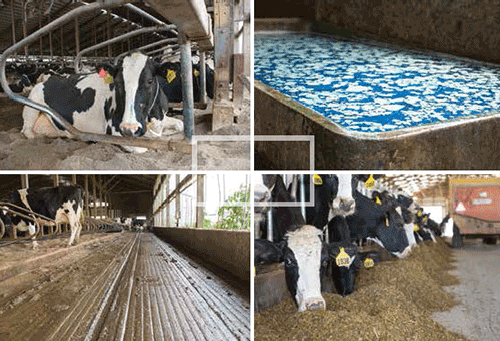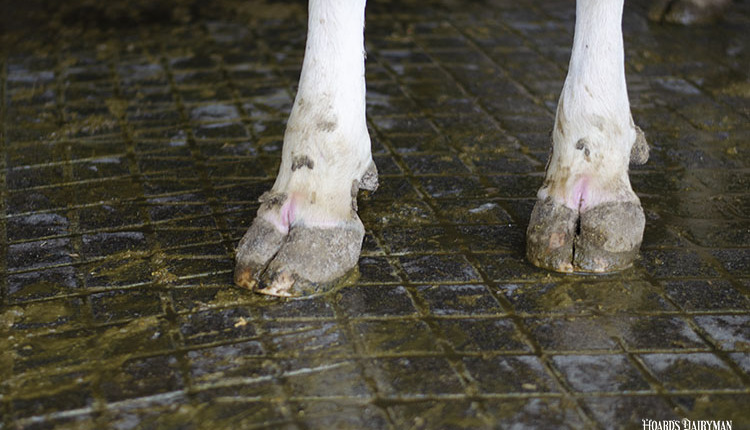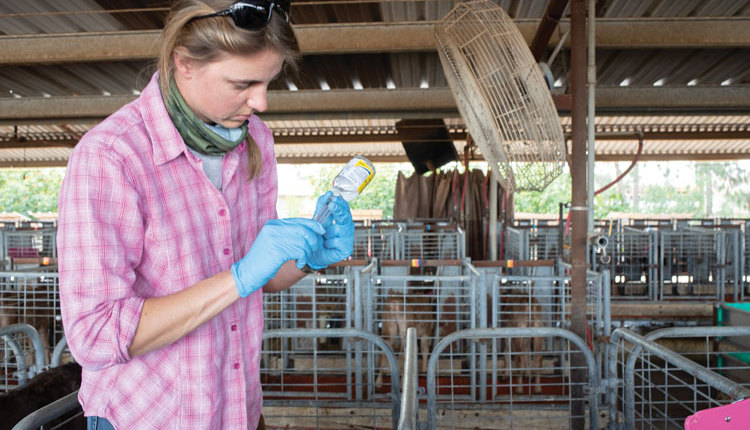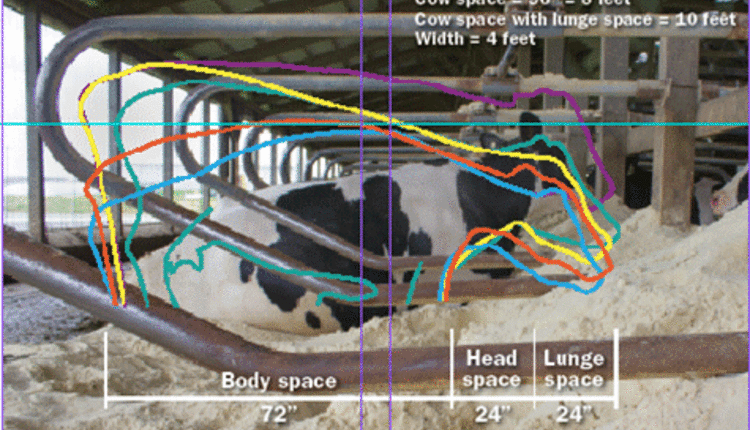Following a long career in dairy genetics, the British Columbia author now writes and consults in the dairy industry. Major funding to support the BC Dairy Hoof Health Group comes from Investment Agriculture Foundation, Westgen Endowment Fund and DIREC (BC Milk Producers).

Put thought into the design of your dairy facilities to ensure use of key elements,
such as footbaths, by cows and employees.
It has been called the most visible animal well-being problem in dairying today - lameness. It's costly, ugly and impairs longevity. If it was easy to fix, we wouldn't have a plethora of experts analyzing the problem and devising solutions. Everyone in the dairy industry should understand the seriousness and need for a full-court press effort to minimize it. That is why industry specialists were brought together at a Dairy Facility Design conference organized by the BC Dairy Hoof Health Group in Abbotsford, British Columbia.
Although the conference focused on housing, John Dick, a dairy veterinarian, and nutritionist Brian Janzen made it clear that nutritional contributors to lameness must also be addressed. Both indicated that SARA (subacute ruminal acidosis), resulting from high-energy diets or sorting, can cause laminitis.
Overcrowding a killer
If cows aren't lying down for the desired 12 hours per day, they are standing too much, putting strain on the suspension structures within the hoof. If they are standing on soft surfaces, presumably the strain is less, but unforgiving concrete floors are the norm in facilities.
Overcrowding is a killer, indicated dairy consultant Jack Rodenburg from Dairy Logix in Ontario. Cows should not have to wait to lie down or to eat! This suggests one stall per cow in each group and 30 inches of linear feedbunk space per cow. Bunk space becomes critically reduced in three- and four-row freestall designs, raising the wait time for feeding.
There's another complication. If cows are routinely waiting to eat, and the TMR permits sorting, the first cows to feed can often get more than their share of grain and the resulting effects of SARA. Designing your facility to allow one stall per cow and 30 inches of bunk space may seem costly at the outset, but it is likely to lower costs associated with elevated lameness and reduced longevity.
He further states that, as competition for feeding space hikes, more displacements occur, especially when only a rail is used along the feedbunk. Timid and younger cows are often the ones left waiting. Standing time should also be kept to a minimum for milking and special events like vet check.
Concrete leads to wear
Hoof trimmer Hugh Smythe shared his views on the damaging effects of aggressively textured concrete floors which can cause excessive wear and/or injury. Following the same theme, ag engineer Harold House described the need for floors to have sufficient traction but not rough, broken, sharp or crowned surfaces.
House notes that cows prefer walking on rubber flooring, which can be very beneficial, when it has adequate texture and softness for good footing. Fasteners that may be used to anchor the rubber can cause injury to hooves, should they become exposed over time.
Concrete that started out with perfect texturing can be worn smooth with scraping, which causes slipping and makes cows more tentative as they move. Remedies include "retexturing," cutting grooves in a variety of patterns and covering with rubber. Barns that use sand bedding have the advantage of grit on the floor at all times.
Dan Weary of the University of British Columbia reported that several studies have revealed higher lameness rates are associated with the use of automatic alley scrapers. That seems counterintuitive since this equipment tends to clean alleys more frequently than manual methods, meaning there should be less manure accumulation.
One theory for this considers the added risk of poor hygiene (elevated pathogen exposure - digital dermatitis), which comes from the "manure tsunami" as the scraper builds more slurry farther down the alley. Another explanation could be the elevated risk of physical injury when cows are stepping on, over or around the scraper, especially when they are rushed or crowded and not comfortable avoiding it.
A third idea points to the slight layer of slurry which is almost always present on the floor due, in part, to the reduced floor slope typical in barns designed for scrapers. Perhaps running the scrapers more frequently could reduce the size of the tsunami, and running it when cows are out for milking could be of some benefit.
Special needs for dry cows
Dry cows were once treated like third-class citizens - they would get the leftovers of facilities and feed because they weren't milking. Much has evolved as we have gained better insight into the importance of good dry cow management as it impacts a successful calving and lactation. Modern building designs incorporate well-planned areas for dry, close-up and fresh cows.
Where freestalls are used, House indicates that 54-inch width is best to permit adequate comfort and to encourage maximum lying time. Overcrowding is again problematic when it reduces lying time and impedes maximizing dry matter intake.
The use of bedding packs for this group is more common, and both Rodenburg and House are fans of deep-bedded packs with good traction surfaces beneath. A minimum of 100 square feet per cow should be allotted. Rodenburg further recommends that cows be calved in clean, comfortable pens adjacent to the close-up group to minimize separation stress, which can also reduce intakes.
Hormones produced at calving time can cause a relaxing of ligaments and tendons in the foot, elevating the susceptibility to injury inside the hoof capsule, making ample lying time a critical factor through this period. Many new dairy facilities recognize the value of a transition group, with either a pack or well-bedded freestalls affording extra comfort and no competition. This will benefit fresh cow hoof health by maximizing lying time, while hormone levels return to normal.
Treatment areas should always be well-lit, safe, familiar, have good traction and be easy to access. This is especially true for hoof trimming chutes, which become vital in the "early recruitment, early treatment" strategy. They should be located in a convenient area off the parlor, using an auto sort gate to conveniently separate cows needing attention.
While most dairies have made efforts to use footbaths, far fewer have effective ones or use them diligently. Like most things in life, the outcome usually correlates to the effort put in. An old-style footbath used once in a while, and left dirty the rest of the time, just doesn't cut it.
Rodenburg shared ideas on proper footbaths, which must be at least 9 feet long to force each foot to dunk twice on the way through. The walls of the chute or alley must be solid and tapered down so there is no curb that could be used to escape the solution. Proper solutions and dilutions should be discussed with your advisers. New technology on the market makes the filling, dosing and cleaning function automatic, which is sure to boost the success rate.
The economics and optics of lameness are serious, and every producer should take advantage of the expertise available to assess their herd and to develop a comprehensive plan which will yield desirable results.
This article appears on page 569 of the September 10, 2013 issue of Hoard's Dairyman.

such as footbaths, by cows and employees.
It has been called the most visible animal well-being problem in dairying today - lameness. It's costly, ugly and impairs longevity. If it was easy to fix, we wouldn't have a plethora of experts analyzing the problem and devising solutions. Everyone in the dairy industry should understand the seriousness and need for a full-court press effort to minimize it. That is why industry specialists were brought together at a Dairy Facility Design conference organized by the BC Dairy Hoof Health Group in Abbotsford, British Columbia.
Although the conference focused on housing, John Dick, a dairy veterinarian, and nutritionist Brian Janzen made it clear that nutritional contributors to lameness must also be addressed. Both indicated that SARA (subacute ruminal acidosis), resulting from high-energy diets or sorting, can cause laminitis.
Overcrowding a killer
If cows aren't lying down for the desired 12 hours per day, they are standing too much, putting strain on the suspension structures within the hoof. If they are standing on soft surfaces, presumably the strain is less, but unforgiving concrete floors are the norm in facilities.
Overcrowding is a killer, indicated dairy consultant Jack Rodenburg from Dairy Logix in Ontario. Cows should not have to wait to lie down or to eat! This suggests one stall per cow in each group and 30 inches of linear feedbunk space per cow. Bunk space becomes critically reduced in three- and four-row freestall designs, raising the wait time for feeding.
There's another complication. If cows are routinely waiting to eat, and the TMR permits sorting, the first cows to feed can often get more than their share of grain and the resulting effects of SARA. Designing your facility to allow one stall per cow and 30 inches of bunk space may seem costly at the outset, but it is likely to lower costs associated with elevated lameness and reduced longevity.
He further states that, as competition for feeding space hikes, more displacements occur, especially when only a rail is used along the feedbunk. Timid and younger cows are often the ones left waiting. Standing time should also be kept to a minimum for milking and special events like vet check.
Concrete leads to wear
Hoof trimmer Hugh Smythe shared his views on the damaging effects of aggressively textured concrete floors which can cause excessive wear and/or injury. Following the same theme, ag engineer Harold House described the need for floors to have sufficient traction but not rough, broken, sharp or crowned surfaces.
House notes that cows prefer walking on rubber flooring, which can be very beneficial, when it has adequate texture and softness for good footing. Fasteners that may be used to anchor the rubber can cause injury to hooves, should they become exposed over time.
Concrete that started out with perfect texturing can be worn smooth with scraping, which causes slipping and makes cows more tentative as they move. Remedies include "retexturing," cutting grooves in a variety of patterns and covering with rubber. Barns that use sand bedding have the advantage of grit on the floor at all times.
Dan Weary of the University of British Columbia reported that several studies have revealed higher lameness rates are associated with the use of automatic alley scrapers. That seems counterintuitive since this equipment tends to clean alleys more frequently than manual methods, meaning there should be less manure accumulation.
One theory for this considers the added risk of poor hygiene (elevated pathogen exposure - digital dermatitis), which comes from the "manure tsunami" as the scraper builds more slurry farther down the alley. Another explanation could be the elevated risk of physical injury when cows are stepping on, over or around the scraper, especially when they are rushed or crowded and not comfortable avoiding it.
A third idea points to the slight layer of slurry which is almost always present on the floor due, in part, to the reduced floor slope typical in barns designed for scrapers. Perhaps running the scrapers more frequently could reduce the size of the tsunami, and running it when cows are out for milking could be of some benefit.
Special needs for dry cows
Dry cows were once treated like third-class citizens - they would get the leftovers of facilities and feed because they weren't milking. Much has evolved as we have gained better insight into the importance of good dry cow management as it impacts a successful calving and lactation. Modern building designs incorporate well-planned areas for dry, close-up and fresh cows.
Where freestalls are used, House indicates that 54-inch width is best to permit adequate comfort and to encourage maximum lying time. Overcrowding is again problematic when it reduces lying time and impedes maximizing dry matter intake.
The use of bedding packs for this group is more common, and both Rodenburg and House are fans of deep-bedded packs with good traction surfaces beneath. A minimum of 100 square feet per cow should be allotted. Rodenburg further recommends that cows be calved in clean, comfortable pens adjacent to the close-up group to minimize separation stress, which can also reduce intakes.
Hormones produced at calving time can cause a relaxing of ligaments and tendons in the foot, elevating the susceptibility to injury inside the hoof capsule, making ample lying time a critical factor through this period. Many new dairy facilities recognize the value of a transition group, with either a pack or well-bedded freestalls affording extra comfort and no competition. This will benefit fresh cow hoof health by maximizing lying time, while hormone levels return to normal.
Treatment areas should always be well-lit, safe, familiar, have good traction and be easy to access. This is especially true for hoof trimming chutes, which become vital in the "early recruitment, early treatment" strategy. They should be located in a convenient area off the parlor, using an auto sort gate to conveniently separate cows needing attention.
While most dairies have made efforts to use footbaths, far fewer have effective ones or use them diligently. Like most things in life, the outcome usually correlates to the effort put in. An old-style footbath used once in a while, and left dirty the rest of the time, just doesn't cut it.
Rodenburg shared ideas on proper footbaths, which must be at least 9 feet long to force each foot to dunk twice on the way through. The walls of the chute or alley must be solid and tapered down so there is no curb that could be used to escape the solution. Proper solutions and dilutions should be discussed with your advisers. New technology on the market makes the filling, dosing and cleaning function automatic, which is sure to boost the success rate.
The economics and optics of lameness are serious, and every producer should take advantage of the expertise available to assess their herd and to develop a comprehensive plan which will yield desirable results.








